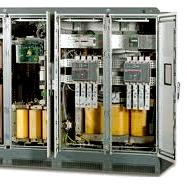A new ‘Introduction to Power Factor Correction Guide’ produced by the BEAMA Capacitor Manufacturers Association (BCMA) and the ECA has been released. It provides fundamental principals and key selection criteria when considering the installation of power factor correction (PFC) equipment to save energy, reduce losses, and hence reduce CO2 emissions. Example data provided also demonstrates the financial savings available:

In installations having reactive loads, PFC can:
- Significantly reduce or eliminate excess reactive power charges.
- Reduce maximum demand (kVA) - providing potential reduction of authorised supply capacity and corresponding costs. Also, in many cases costly distribution infrastructure up-grade can be avoided.
- Reduce system losses and voltage drop - improving performance and reducing energy consumption (kWh) and CO2 emissions.
A recent report commissioned by the BCMA suggests that savings of up to 146kg of CO2 per annum could be saved for each kVAr of PFC installed, as opposed to 105kg as previously calculated.
New technical bulletin too:
In addition, a new Technical Bulletin quantifies the effect of low voltage PFC on losses and CO2 emissions in the UK transmission and distribution system.
In April 2010, all UK mainland distribution network operators (DNOs) adopted a common methodology for applying 'use of system' charges (CDCM). This includes a charge for excess reactive power based on every kVArh in excess of 33% of kWh consumption in each half hour period. This charge applies to both imported (lagging) and exported (leading) kVArh units. Essentially, a PF of 0.95 or better should be maintained at all times and load conditions.
Traditionally, PFC equipment has been applied as fixed or automatic multi-stage compensation (or a combination of both). The CDCM has made dimensioning the correct equipment much more complex, and fixed type compensation may not necessarily be financially viable for sites with a non continuous load profile unless applied to specific loads.
The BCMA is working with the energy providers to ensure that consumers have full information regarding power factor correction and losses on their installations.
To download both documents, please click on the
links below ('Introduction to PFC Guide' - PDF: 433kB file size, and the
'Technical Bulletin' - 132kB file size).
About BEAMA:
BEAMA (British Electrotechnical and Allied Manufacturers Association) has been established for over 100 years, covering a range of industries in the electrical, energy, water and power related sectors. It represents directly some 150 companies in the UK electrotechnical and allied manufacturing industries. BEAMA members produce equipment required for smart grids, metering and homes. BEAMA represents members' interests in generic and specific areas within Government/ Governmental organisations, UK and international standards and industry players.
BEAMA members are active in many market sectors including commercial and residential buildings and energy networks.
BEAMA is a proactive trade association advising its members on relevant technology and market developments, particularly relating to the areas of product safety and sustainability.
BEAMA still retains its prime purpose - serving members and the national
industrial base as the recognised electrotechnical industry association.
For
more BEAMA information visit www.beama.org.uk.
About BCMA:
The BEAMA Capacitor Manufacturers Association (BCMA) is an association whose member companies produce wound capacitors of film, paper or mixed dielectric construction, with or without solid foils, for operation on AC or DC systems having outputs generally in excess of 1.0 microfarad or 100V RMS or DC.
BCMA members join with international members of the industry in developing
standards through IEC. BCMA also promotes their technology in the UK through
providing technical advice to potential customers and by advising Government of
the advantages of [Power Factor Correction (PFC).
The Electrical Contractors' Association (ECA) is the UK's leading trade association representing the interests of contractors who design, install, inspect, test and maintain electrical and electronic equipment and services.
The ECA has three clear aims:
- To provide a comprehensive, first-class range of tools and expert support services to its 3,000+ Registered Members.
- To work with regulatory bodies, government and opinion formers to build an efficient and sustainable industry, based on high standards of training and practice.
- To form strategic relationships with those who specify electrical work to
enhance the profile and promote the use of Registered Members of all sizes,
improving their profit potential.
